DataFrame Pandas Reindex
Reindexing in pandas is a critical tool for data manipulation and analysis, allowing you to align data according to a new set of labels. This is particularly useful when you want to conform one series or DataFrame to another, ensuring that they have the same index for comparative analysis or when combining multiple data sources with potentially different and misaligned indexes.
This article will explore the concept of reindexing in pandas, providing a comprehensive guide on how to use the reindex method with various parameters and scenarios. We will cover basic reindexing, filling missing values during reindexing, reindexing with different objects, and more advanced techniques.
Basic Reindexing
Reindexing allows you to change the index of a pandas DataFrame or Series. This can be useful when the data input order needs to be rearranged or when indexes are missing or incomplete.
Example 1: Basic Reindexing of a DataFrame
import pandas as pd
data = {'Name': ['Alice', 'Bob', 'Charles'],
'Age': [25, 30, 35]}
df = pd.DataFrame(data, index=[0, 1, 2])
new_index = [2, 1, 0]
df_reindexed = df.reindex(new_index)
print(df_reindexed)
Output:
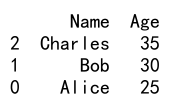
Example 2: Reindexing with Missing Index Labels
import pandas as pd
data = {'Name': ['Alice', 'Bob', 'Charles'],
'Age': [25, 30, 35]}
df = pd.DataFrame(data, index=[0, 1, 2])
new_index = [2, 1, 3] # Note index '3' does not exist in the original DataFrame
df_reindexed = df.reindex(new_index)
print(df_reindexed)
Output:
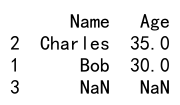
Filling Missing Values During Reindexing
When reindexing results in the introduction of missing values, pandas provides options to handle these, such as filling them with a specified value or using a method to interpolate the values.
Example 3: Using fill_value Option
import pandas as pd
data = {'Name': ['Alice', 'Bob', 'Charles'],
'Age': [25, 30, 35]}
df = pd.DataFrame(data, index=[0, 1, 2])
new_index = [2, 1, 3]
df_reindexed = df.reindex(new_index, fill_value='Missing')
print(df_reindexed)
Output:
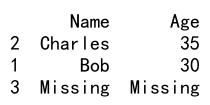
Example 4: Forward Filling Missing Values
import pandas as pd
data = {'Name': ['Alice', 'Bob', 'Charles'],
'Age': [25, 30, 35]}
df = pd.DataFrame(data, index=[0, 1, 2])
new_index = [0, 1, 2, 3]
df_reindexed = df.reindex(new_index, method='ffill')
print(df_reindexed)
Output:
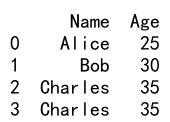
Reindexing Using Different Objects
You can also reindex using other objects like another DataFrame or Series. This is particularly useful when you need to align two datasets.
Example 5: Reindexing Using Another DataFrame’s Index
import pandas as pd
data1 = {'Name': ['Alice', 'Bob', 'Charles'],
'Age': [25, 30, 35]}
df1 = pd.DataFrame(data1)
data2 = {'Name': ['David', 'Eve'],
'Age': [40, 22]}
df2 = pd.DataFrame(data2, index=[2, 3])
df1_reindexed = df1.reindex(df2.index)
print(df1_reindexed)
Output:

Example 6: Reindexing Using a Series
import pandas as pd
data = {'Name': ['Alice', 'Bob', 'Charles'],
'Age': [25, 30, 35]}
df = pd.DataFrame(data)
index_series = pd.Series([2, 1, 0])
df_reindexed = df.reindex(index_series)
print(df_reindexed)
Output:

Advanced Reindexing Techniques
Advanced reindexing techniques involve using multi-level indexes, datetime indexes, and reindexing from a function.
Example 7: Multi-Level Index Reindexing
import pandas as pd
data = {'Name': ['Alice', 'Bob', 'Charles'],
'Age': [25, 30, 35]}
df = pd.DataFrame(data, index=pd.MultiIndex.from_tuples([(0, 'a'), (1, 'b'), (2, 'c')], names=['id', 'sub']))
new_index = pd.MultiIndex.from_tuples([(2, 'c'), (1, 'b'), (0, 'a')])
df_reindexed = df.reindex(new_index)
print(df_reindexed)
Output:
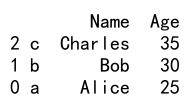
Example 8: Reindexing with Datetime Index
import pandas as pd
import datetime
dates = pd.date_range(start='2023-01-01', periods=3, freq='D')
data = {'Name': ['Alice', 'Bob', 'Charles'],
'Age': [25, 30, 35]}
df = pd.DataFrame(data, index=dates)
new_dates = pd.date_range(start='2023-01-02', periods=3, freq='D')
df_reindexed = df.reindex(new_dates)
print(df_reindexed)
Output:
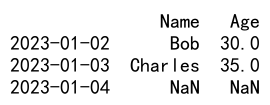
Example 9: Reindexing Using a Function
import pandas as pd
data = {'Name': ['Alice', 'Bob', 'Charles'],
'Age': [25, 30, 35]}
df = pd.DataFrame(data, index=[0, 1, 2])
def new_index_function(x):
return x * 2
new_index = map(new_index_function, df.index)
df_reindexed = df.reindex(list(new_index))
print(df_reindexed)
Output:
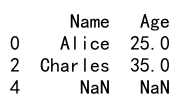
DataFrame Pandas Reindex Conclusion
Reindexing in pandas is a powerful feature that allows for flexible manipulation and alignment of data. By understanding how to effectively use the reindex method, you can handle complex data transformation tasks with ease. Whether you are dealing with missing data, aligning datasets, or working with advanced indexing techniques, reindexing provides the tools necessary to prepare your data for analysis.
 Pandas Dataframe
Pandas Dataframe